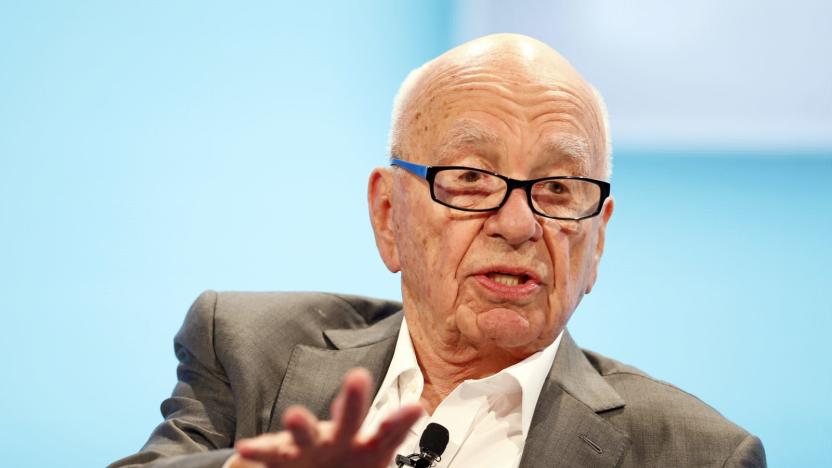newspapers
Latest

Google’s plan to improve local news will start in Youngstown, Ohio
Today, Google announced that Youngstown, Ohio, will be the first city in its Compass Experiment, a joint venture with newspaper publishing company McClatchy to revive local news. The announcement couldn't be more timely, as Youngstown's long standing publication The Vindicator will close its doors on August 31st.

Facebook can't find enough local news for its local news service
Facebook hoped to help people across the US stay more informed about local news, information and events when it launched its Today In feature in November. But Facebook says it's having trouble finding enough news to feed into the service -- in part because it hastened the demise of hundreds of local newspapers.

Facebook will spend $300 million to help local newsrooms
Facebook is investing $300 million into news partnerships over the next three years in a bid to boost local newsrooms. It's all part of its ongoing efforts to mend ties with the press while cleaning up misinformation on its site. Along with the $20 million Facebook has already doled out as part of its local news partnerships expansion, it will distribute $16 million among the following non-profits and support organizations: Pulitzer Center, Report for America, the Knight-Lenfest News Transformation Fund, the Local Media Association, the Local Media Consortium, the American Journalism Project, and the Community News Project.

Ofcom to investigate Sky and 21st Century Fox merger
The UK's media regulator will investigate a proposed merger worth £11.7 billion ($14.6 billion) between 21st Century Fox and Sky. Speaking in the House of Commons, Karen Bradley, the Secretary of State for Culture, Media and Sport, said she had referred the matter because of "public interest considerations" which "warrant further investigation." These include media plurality -- the need for citizens to have access to a variety of independent news sources -- and a "commitment to broadcasting standards." Ofcom has 40 days to investigate and deliver its report, which will undoubtedly shape Bradley's decision to approve or block the deal.

New stats show how many newspaper jobs the internet has claimed
Anyone reading this, an article that exists only on the internet, is aware of the dramatic shift that's taken place in the media world since the 1990s. As internet penetration has grown, newspaper sales have dipped dramatically, as have traditional newspaper jobs. New research from the US Bureau of Labor Statistics quantifies these losses -- and they're hefty.

New York Times offers newsstand customers 'Digital Day Passes'
The New York Times is launching a new "digital day pass" program today to help convince folks that still buy the paper at newsstands to instead get their news from its website. The day pass will grant access to the publication's website and apps for the day to anyone that buys a physical paper. Each paper will include a keyword that the customer will text to the number provided and receive a link that activates their digital access. Of course, if the customer doesn't yet have a NYTimes.com account, they'll need to create one. The day's access will be revoked at midnight every night.

EU court rules that reading online news doesn't violate copyright
You probably didn't know it, but the legality of what you're doing right now has been a hotly debated issue in EU courts -- reading articles online. For the last four years the Public Relations Consultants Association (PRCA) and the Newspaper Licensing Agency (NLA) have been trying to determine if browsing and viewing copyrighted material online required the authorization of the copyright holder; today the Court of Justice of the European Union (CJEU) ruled that it does not. It sounds like a no-brainer, but the facts are a little more complicated: the two groups were arguing over the application of licenses to media monitoring agencies and their effects on the end-user.

The Telegraph erects paywall for UK readers
The Telegraph has had a paywall in place for international readers since November, and now its spreading the subscription model to folks in the UK. Despite the slow rollout, the price tiers are staying the same: £1.99 a month nets unlimited access to the newspaper's website and mobile apps, while £9.99 per month grants the same perks, plus use of its tablet editions. Each subscription comes with a free trial before you're charged, but you could keep your wallet shut and skate by on 20 free articles every month. If you're already subscribed to the dead tree version of the publication, however, you'll be able to reap the benefits of its digital incarnations without spending any extra pennies pence. [Image credit: Pleasance, Flickr]

Google runs newspaper ad for Google ads, universe has yet to implode
Google knows how to tug at your heart strings when promoting its services, but it also has the whole irony thing down pat. Last Thursday, the search giant touted the advantages of its targeted advertising in the Canadian newspaper the Globe and Mail, taking out a large spread asking the delightfully smug question you see above. Lest you think Google's pitch for AdWords wasn't in earnest, the ad also appeared on the Globe's website.

New York Times sees higher circulation numbers, digital paywall smiles knowingly
Given how aggressively The New York Times pushes its digital packages -- we've long since dropped our subscription yet are still bombarded with offers -- you'd hope the paper was at least seeing some results. Well, never fear: it is. A report by the Audit Bureau of Circulations (ABC) found that the Times has seen a healthy increase in circulation, with the Sunday edition selling 2,003,247 copies (up 50 percent from last year) and the weekday editions racking in an average of 1,586,757 (up 73 percent). The ABC attributes much of this gain to the NYT's addition of digital access to paper subscriptions, and we're sure the paywall, which limits non-subscribers to just ten free articles a month, has something to do with it, too.

Amazon bringing 400 magazines, newspapers, flame retardants to Kindle Fire
It's been a busy week for the Kindle Fire. First came news that Amazon would be bringing Facebook, Hulu and "several thousand" other apps to its forthcoming tablet, and now, we've got confirmation that hundreds of magazines and newspapers are on their way, as well. Yesterday, the company announced that more than 400 "full-color" titles will be available on the Kindle Fire Newsstand, including Us Weekly, The New Yorker and Reader's Digest, among others. Users who subscriber before March 1st, meanwhile, will be able to access a full 17 Condé Nast titles for free, as part of a three-month offer. Amazon is also promising plenty of interactive editions with built-in video and audio, which you'll be able to check out for yourself next week, when the Fire begins shipping. For more details, check out the full press release after the break.

Philly newsies to offer Archos Arnova 10 G2 tablet for $99 with subscription bundle
Taking a cue from other publications pushing tablet content, two major Philadelphia newspapers are offering discounted subscriptions bundled with a discounted device to read it on -- the Android-based Arnova 10 G2. The Philadelphia Media Network and Arnova will offer the tablet for $99 when purchased with a two-year digital subscription to The Philadelphia Inquirer and Daily News for $9.99 a month, or $129 for the year. That tally is substantially lower than the HK $1,680 (around $250) mark that the slate alone hit when it launched last month, but it's not apt to attract too much attention outside of Brotherly Love's favorite locale. So... which paper's lined up to play copycat? Check out the more coverage link after the break for some hands-on video with the tablet.

Report: Tribune wants to build its own tablet
CNN reports that newspaper and broadcast company Tribune wants to build a tablet for subscribers to access properties like the Los Angeles Times and The Baltimore Sun. The tablet will be based on Android and offered for free or at a heavily subsidized price. Tribune hasn't made a lot of great decisions in the past couple of years, and this smells like another bad one. Some of the very customers that would be interested in Tribune's potential hardware offering likely have a tablet already, and the odds are good that the tablet they have is an iPad. Does Tribune expect people to carry around two tablets, one for reading a Tribune paper and one for everything else? Or maybe the Tribune tablet will just be a branded Android tablet... but last time I looked those aren't selling too well. By the way, how is the RIM PlayBook doing? Or the Crunchpad? Enjoying those Microsoft tablets? Distributing a newspaper through the App Store may not be a palatable option for publishers because of the high toll Apple takes, but trying to produce your own hardware when so many others have failed seems a heck of a lot riskier. I think competition is great, and Apple needs some. But the grim reality is that, so far at least, no one has produced a tablet that matches the experience and price of the iPad. We've seen magazines and newspapers try to meet the digital challenge a number of ways. The New York Times lost a lot of subscribers when it put up a pay-wall, but it has had some modest success by still letting non-subscribers get access to limited amounts of news. The Daily from News Corp. appears to be a failure so far, but there is still a lot of room to experiment with what works and what doesn't. And note that all of those experiments are running on the iPad, not dedicated, poorly-selling hardware. I'd put Tribune building its own tablet in the latter category, but maybe I'm short sighted and naive. What do you think about the Tribune plan?

Huffington Post adds 'Classic Edition' to iPad app
I'm happy to report that The Huffington Post has updated their iPad app to version 3.0 today and has added a "Classic Edition" layout option to the app. Back in December, The Huffington Post released version 2.0 of their iPad app. While in some ways it was an improvement over version 1.0. The developers went a little interactive-menu crazy and unveiled this new thing called newsglide. The intention of newsglide was to enhance navigation, but one also got the feeling that the company wanted to add eye-candy to their app just because it looked cool while using it. I wrote: "The old app had a very newspaper-like feel to it as far as navigation goes. The new app seems to be the love child that would result if the BBC for iPad and Twitter apps hooked up. Personally, I like my newspaper apps to have the layout of newspapers." With today's version 3.0 release, newsglide is still there, but users can select between reading the app in newsglide view or classic view. Classic view is just that -- it retains the look and layout of a classic newspaper. In my opinion, that's all an iPad newspaper app has to do to be a good app. After all, a newspaper (even an Internet-only one) is meant to be read. It's not important for me to feel like I'm Tom Cruise in Minority Report while reading about the latest economic troubles. I want the text, the information, and all new apps should focus on providing that over any eye-candy interactivity. Pamela Maffei McCarthy, The New Yorker's deputy editor, said it best when she told The New York Times shortly after it was announce that The New Yorker's iPad edition was outselling other iPad magazines that had more eye-candy interactivity. "That was really important to us: to create an app all about reading," she said. "There are some bells and whistles, but we're very careful about that. We think about whether or not they add any value. And if they don't, out the window they go." I'm glad The Huffington Post seems to now agree and hopefully other newspapers will too. The Huffington Post for iPad is a free download.

Philly papers to offer subscribers discounted Android tablets that make terrible birdcage lining (video)
As the internet has overtaken newspapers as an information source, convincing readers to shell out the dough for online news has proven an uphill battle. Now two papers are trying a new approach: entice customers with discounted Android tablets and pre-loaded content apps. The Philadelphia Media Network, which owns the Philadelphia Inquirer and the Philadelphia Daily News, is planning a pilot program for mid-August which will offer around 2,000 tablets; if successful, it could expand to more readers. The combined price of hardware and a one- to two-year daily subscription should be about half of retail. So far we have few details on what you'll get for your money, but expect a WiFi tablet from a major manufacturer, with 3G and/or 4G possible in the future. If you're from the city of brotherly love and want more details on this early-stage plan, see the video after the break.

New York Post blocks iPad access through Safari browser, hopes you'll pay for a subscription instead
Well, that's one way to make people pay for puns. The New York Post, that bastion of fair, balanced, and not-at-all sensationalistic reporting, has blocked iPad owners from reading its stories through the tablet's Safari browser. If folks want the full spill on Hugh Hefner getting ditched at the altar, they'll be prompted to download the iOS app, which requires signing up for a subscription starting at $6.99 on a month-to-month basis. Setting aside News Corp.'s hubris for a moment, what's odd about this is the number of workarounds Rupert Murdoch & Co. left us cheapskates. You can still read the site on a desktop browser or a phone, including an Android one. Basically, then, News Corp. is strangling web access, but only for a select group of readers. That's a stark contrast from other content providers (even the News Corp-owned Wall Street Journal), which have been more platform-agnostic. Then again, there's the dim possibility that News Corp. targeted the iPad in an effort to re-brand the Post as a glossier sort of tabloid, à la The Daily. To which we say, that's some wishful thinking there, Rupe.

UK newspaper The Telegraph offers subscriptions through iPad
The UK newspaper The Telegraph has released version 2.0 of its iPad app. The updated app features a 30-day archive, night reading mode and greater depth of content, including video, picture galleries, graphics and cartoon archives. However, the big feature of the updated app is the pricing plans. Users can now download the paper each day for £1.19 (US$1.99). Admittedly, that is rather pricey, but The Telegraph makes up for its daily rates by offering monthly subscriptions for £9.99 (U$16.99). That's 70% off the daily rate, and considering The Telegraph is published every day, that's quite a bit of information for your buck (or quid). For those keeping track, a monthly subscription to the paper edition is £26.40, so the iPad edition saves you quite a lot. Also, Telegraph readers who currently have a subscription to the paper edition can download the iPad edition for free by entering their subscriber number. Readers should note that, as with traditional newspaper subscriptions, the monthly subscription to the iPad edition is auto-renewing, so users will need to cancel it or they will be automatically billed when the next month comes up. The Telegraph for iPad is a free download. [via Electronista]

Online news overtakes paper, and nearly half of it is mobile
Wait, this is just now happening? The Pew Project's 2011 report on mobile devices' effect on media was published this week; it's a fascinating read from end to end that reveals a wild swing in the way we've gathered news and information as human beings over the past decade, but a couple stats really stand out. First off, the internet has finally overtaken newspapers as a news source, putting it behind just television -- and we already know the writing's on the wall there since the young ones are already preferring the web. And of those web-savvy, voracious consumers of information, some 47 percent are getting at least some of it on the go, either through their phone or tablet (like, say, Engadget's lovely selection of mobile apps). Mass transit commuters have always been a haven for newspaper-toting businessfolk -- but with iPads continuing to sell like hotcakes, not even the subway is safe from the tablet onslaught.

Apple Xcode magazine template could streamline iPad publishing
Magazines and newspapers on the iPad would appear to be a perfect match for the device, but attempts such as Rupert Murdoch's The Daily and Sir Richard Branson's Project have met with limited success. There are many possible reasons for this, ranging from Apple's demands for 30 percent of all revenues from in-app purchases of subscriptions to the lack of a consistent user experience. The latter seems to be the biggest problem for many potential readers, since each magazine or newspaper seems to have its own unique method of navigating pages. Gadget Daily News is claiming that Apple has an answer in the works: a magazine template for the Xcode development environment that will provide a consistent, manageable user experience. The template will not only provide a familiar look and feel between all magazines and newspapers that are developed using the code, but also make it simple to sell subscriptions and back issues from within the app. According to Gadget Daily News, this should open up iPad publishing considerably, since people who wish to create and sell their own content need only get together with a developer to get their magazines or newspapers into the App Store in a short amount of time. The template could open up a huge new market for what blogger Anthony Morganti calls "Garage Magazines" -- self-published magazines that target a specific market. That's an apt moniker, considering that the company making this possible began its life in a garage. The template is expected to arrive before the end of 2011. Let's just hope that self-titled magazines like the one shown in the illustration above don't become commonplace. [via Electronista]

Elle, Nylon and Pop Sci gladly adopt Apple's subscription terms
Not every publisher's feathers were ruffled by the changes Apple made to its subscription policy earlier this week. While Rhapsody may have responded negatively to the changes, some publishers are accepting the new terms and adopting Apple's new subscription model. According to Advertising Age, three popular magazines, Elle, Nylon and Popular Science, will let customers subscribe via the App Store and, in return, will concede some of their valuable customer data to Apple. The trio believes the advantages of distributing content via Apple's mobile platform outweigh any potential disadvantages. Nylon is the smallest magazine of the bunch and will be least affected by the loss of customer information. The independent magazine eyes the monetary reward of increased subscriptions and assumes its customers will still provide demographic information via other methods. Popular Science shares a similar approach and may prompt users to share their information after they have purchased a subscription and received their second or third issue of the digital magazine. Hachette Filipacchi Media U.S., the publisher behind Elle magazine, is taking a wait and see approach. Rather than become enemies with Apple, the magazine is going to adopt the model and see how it turns out. The publisher also sees the model as being very fluid and one that Apple and publishers can modify over time. "I don't think this is something that is set in stone either for us or for Apple. I'd rather work with them to improve it over time than just sit on the sidelines," said Philippe Guelton, Executive Vice President and COO at Hachette Filipacchi Media U.S.















